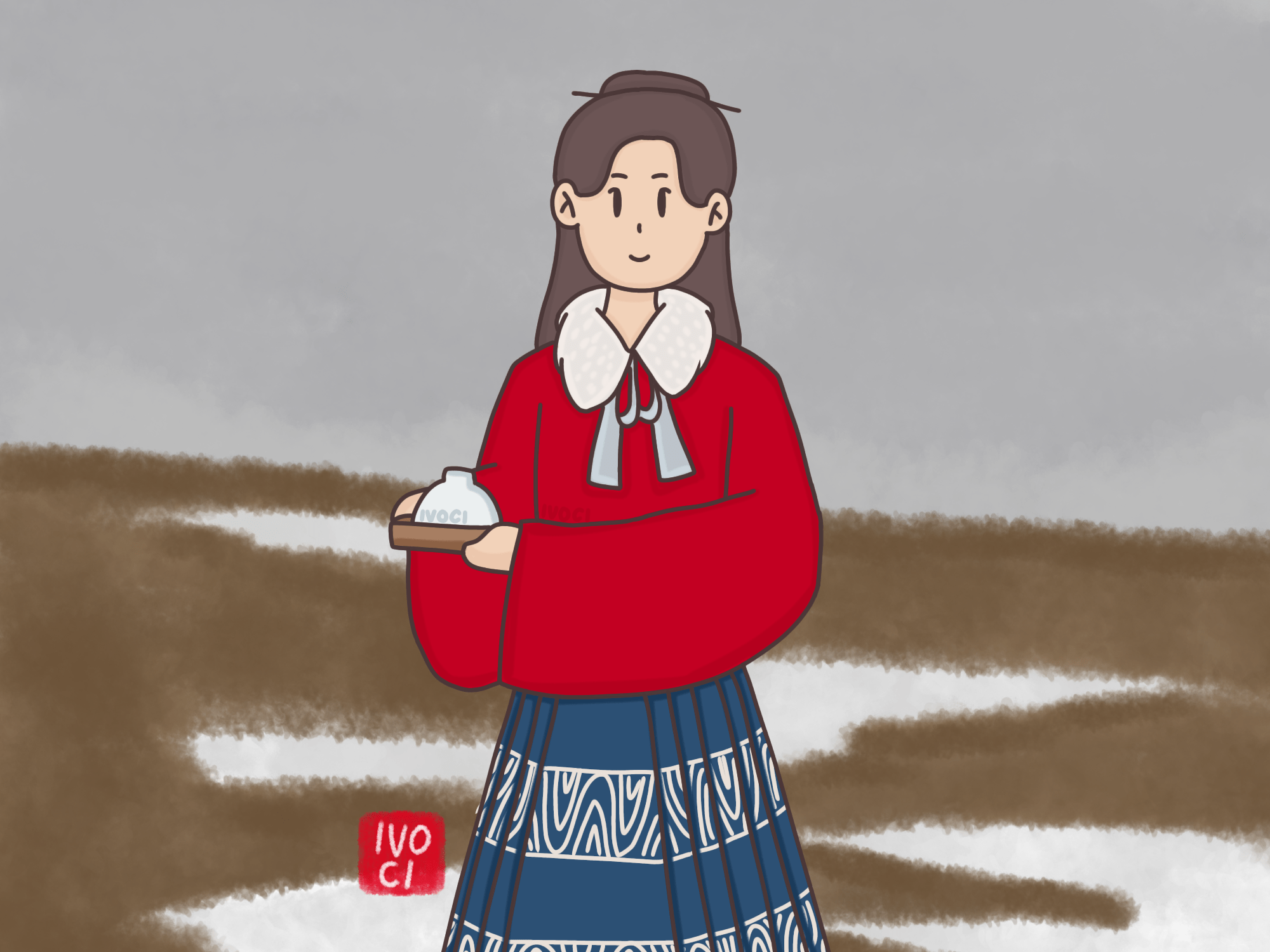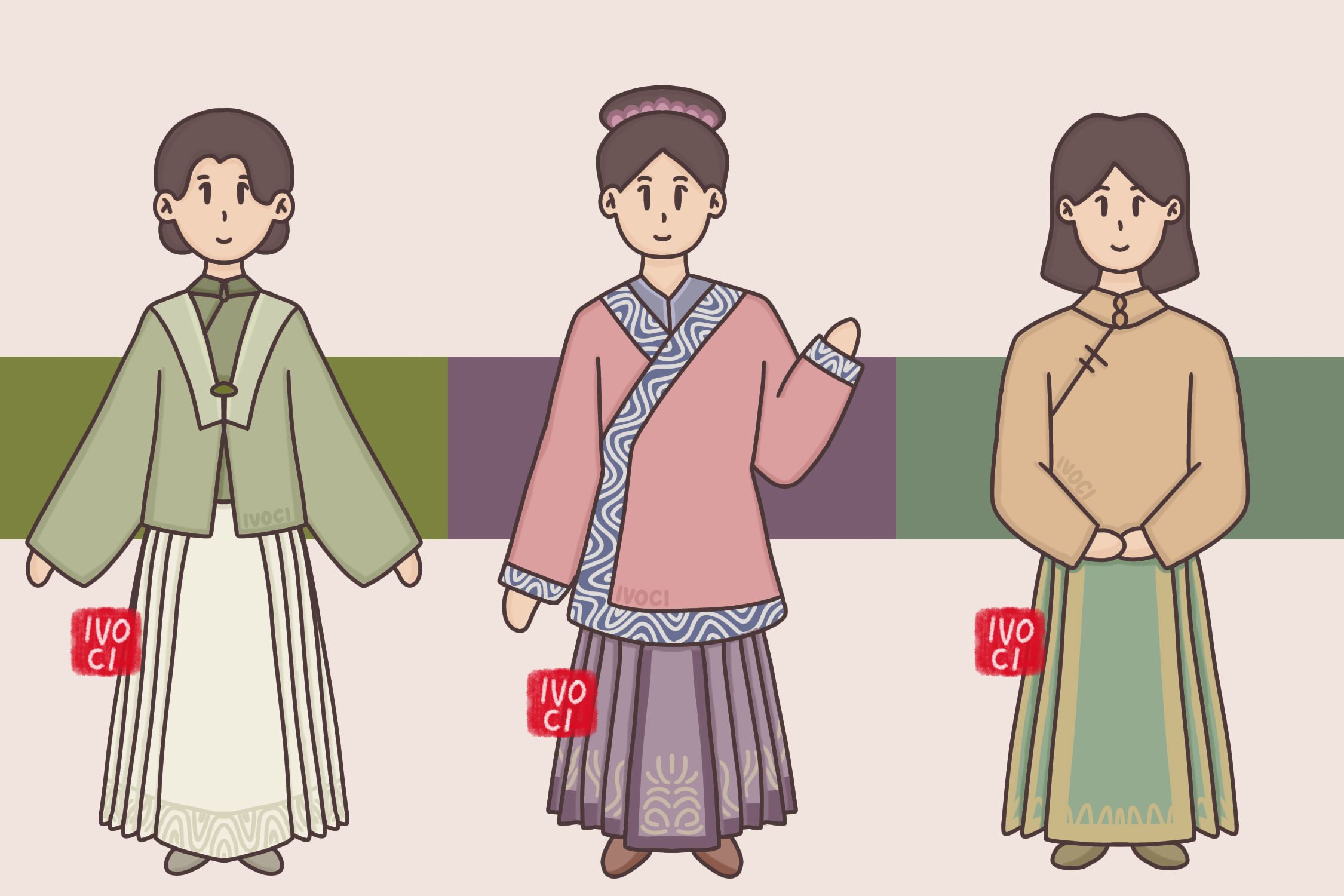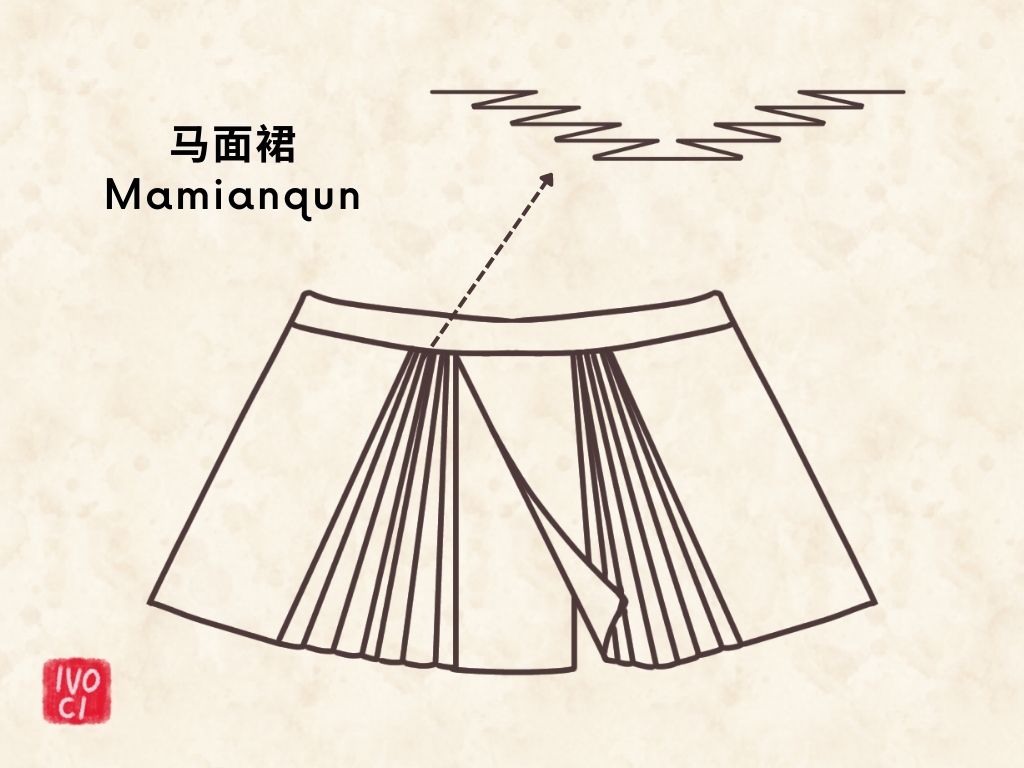Mamianqun (Chinese: 马面裙 ; pinyin: mǎ miàn qún) is a type of skirt worn by Han Chinese women as the bottom of a garment item in Hanfu.
Mamianqun consists of three Chinese characters: ‘mǎ 马’ which means ‘horse’; ‘miàn 面’ which means ‘face’; and ‘qún 裙’ which means ‘skirt’.
Mamianqun is one of the main representatives of the ancient Chinese style skirt.
Mamianqun was the most distinctive style of women’s clothing in the Ming and Qing dynasties.
Mamianqun originated in the Song and Liao dynasties and became popular for its functionality and aesthetics. It continued to be worn in the Yuan, Ming, and Qing dynasties.
Mamianqun has undergone a series of changes from fresh and elegant in the Ming dynasty to beautiful and rich in the Qing dynasty, and then to the beauty and simplicity of the Republic of China, but its “horse face” structure has always been deeply rooted.
In the 21st century, mamianqun revived its popularity with the revival of the Hanfu movement.
Development
From the Song dynasty to the Ming dynasty, mamianqun was gradually formed.
During the Song dynasty, mamianqun first appeared and seemed to be able to absorb some influences from the clothes worn by China’s nomadic neighbors. There are two forms of the draped skirt associated with the early prototype of the mamianqun and with the mamianqun that continued to be used in the Qing dynasty. The two forms of wrapped skirts were found in the Song dynasty tomb of Huang Sheng in Fuzhou, Fujian, China.
In the Yuan dynasty, mamianqun appeared which was made of two cloths and could be found pleated. The belt is made of a different fabric than the one used for the skirt.
During the Chenghua period of the Ming dynasty, people in the capital liked to wear mamianqun. From queens to commoners, everyone wears mamianqun.
For different grades, the texture, decoration and color of the mamianqun are very different.
Based on inheriting the mamianqun style of the Ming dynasty, the mamianqun in the Qing dynasty gradually developed into the everyday clothing of Han women in the Qing dynasty through further evolution, and became the iconic skirt style of women in the Qing dynasty.
Mamianqun developed most rapidly during the Qing dynasty and formed a unique style of decorative structure, which was the basic form of skirts in the Qing dynasty.
In the early 20th century, the Qing government gradually collapsed. Mamianqun in the early Republic of China still inherited and developed the loose style, bright colors, and complex craftsmanship of the Qing dynasty.
After the May 4th Movement, influenced by the idea of ”democracy and freedom”, the difference between Chinese women’s skirts and Western women’s skirts became smaller, and the elements of traditional women’s skirts gradually disappeared, which also shows that mamianqun is nearing the end.
With the continuous simplification of skirt styles, in the 1930s, the mamianqun embroidered skirt was gradually eliminated in people’s lives, and was replaced by the cheongsam, and others.
Skill
Shape
1. Mamianqun in the Ming dynasty
Mamianqun in the Ming dynasty generally uses 7 pieces of cloth.
Both ends of the skirt are sewn with laces, the skirt is wide, and the skirt is woven or embroidered with decorations at the bottom.
Mamianqun decorations often adopt auspicious patterns with rich meanings, and women from official families use more elaborate dragon patterns, cloud python patterns, etc.
The combination of mamianqun forms the basis for the rich and bouncy mamianqun forms.
By the end of the Ming dynasty, the skirt had increased to ten pieces of cloth, and the pleats around the waist became denser.
2. Mamianqun in the Qing dynasty
In the Qing dynasty, Han women could continue to inherit the Ming dynasty style of clothing.
a. Yuehuaqun
Yuehuaqun (Chinese: 月华裙 ; pinyin: yuè huá qún) was one of the most popular forms of the mamianqun style variant in the Qing dynasty. It appears at least in the 17th century when it was recorded by Li Yu (李漁).
b. Fengweiqun
Fengweiqun (Chinese: 凤尾裙 ; pinyin: fèng wěi qún) appeared in the Qing dynasty during the Qianlong period as late as 1750. According to the author, Shaorong Yang, fengweiqun embroidered with gold thread and made of damask was worn in the late Ming and early Qing dynasties. It became the most popular style during the Kangxi and Qianlong periods.
Fengweiqun is mostly worn by women who come from rich families, but women from less wealthy families may wear fengweiqun as a wedding skirt. The style continued even in the Republic of China period.
Fengweiqun is characterized by a long, narrow strip of fabric with a sharp lower hem that can be sewn to the waist of the skirt. The edge of the strip of this fabric can also be decorated with gold thread or lace, which will make the skirt look very luxurious. Sometimes decorated with ribbons and small bells.
c. Yulinqun
Yulinqun (Chinese: 鱼鳞裙 ; pinyin: yú lín qún) emerged in the late 19th century and became popular. It was very popular in Beijing in the 1860s during the Tongzhi era. Yulinqun continues to be used by actors in Peking operas.
Yulinqun has two overlapping flat panels and side folds. Its main characteristic is the use of hundreds of small folds which are then tied together with layers of a horizontal seam in a wave pattern that divides these folds into sections. The overlap of these folds will then give the impression of a fish scale pattern.
The pleats can also be secured to the skirt through the use of handcrafted basting stitches on the inside in alternating patterns, this will then create a honeycomb effect, this form of pleat effect is also referred to as fish scale pleats.
d. Langanqun
Langanqun (Chinese: 阑干裙 ; pinyin: lán gān qún) is characterized by sharp lines (usually black) in the form of a lan gan.
3. Mamianqun in the Republic of China
In the Republic of China, the mamianqun was still worn by Han Chinese women even when the cheongsam was made in the 1920s. However, the style also changed and the mamianqun eventually became plain and unadorned, and became shorter.
In the early Republic of China, the mamianqun fastening method already used plastic buttons in addition to straps and buckles.
Mamianqun is also used in wedding dresses. This type of skirt is called the Hongxi skirt. This was a wedding dress for women in the late Qing dynasty and the early Republic of China.
Cloth
The mamianqun cloth in the Qing dynasty is plain, and there is no big change compared to the Ming dynasty.
Mamianqun fabrics are mainly composed of silk and satin, and the composition of different styles of fabrics is not the same.
Sew
Because the width of the fabric was narrow at that time, the width of a single fabric could not meet the crease margin, so it was often spliced with several fabrics. The width of the modern fabric is relatively wide, and the single width can also meet the needs.
According to the traditional fabric width, 6 pieces of 50 – 60cm wide, waist to ankle length can be cut, and three pieces combined into two pieces as two skirt widths.
According to modern fabric width, 150 – 180cm width can also be cut, into two pieces of fabric of the same length.
Culture
Mamianqun is colorful, mostly red and blue.
Red is the most popular color in traditional Chinese culture because it symbolizes good luck and joy.
According to Han customs, women usually wear red skirts during celebrations such as weddings and festivals.
In the Qing dynasty, blue mamianqun was also common, as a popular color at the time, often paired with black and yellow.
Mamianqun patterns can be divided into individual embroidery fabric patterns and broad embroidery fabric patterns, of which individual embroidery fabric patterns make up the majority. Each of these patterns conveys a different meaning.
Like animal patterns, in the development of traditional history, dragon and phoenix patterns have always been respected by every Chinese person.
Most of the dragon and phoenix patterns appeared in the clothes of every harem emperor and concubine. Dragons and phoenixes also symbolize the love between a man and a woman or a beautiful marriage.
The pattern of plants and flowers give a beautiful meaning to the pattern through the different qualities.
The peony flower is the national flower representing wealth and honor.
Lotus, which emerges from the mud and does not become stained represents the cleanliness of jade.
Chrysanthemum symbolizes longevity.
Lily symbolizes purity and friendship, implies a hundred years of good harmony, and the future life is full of sunshine.
Historical Value
During the Ming and Qing dynasties, the feudal system gradually declined and the unity of the multi-ethnic state was consolidated and developed.
The Qing dynasty was the era when mamianqun was popular and the style of mamianqun also changed from being fresh and elegant in the Ming dynasty to being beautiful and rich in the Qing dynasty.
The decorative meaning of mamianqun in the Qing dynasty became increasingly strong.
In the 21st century, the Ming-style mamianqun has become a popular form of skirt for Hanfu fans.
Since the beginning of the Hanfu movement around 2003, more modified variations of the modern-style mamianqun based on Ming dynasty designs, such as the shorter mamianqun (e.g. above the knee, mid-calf, and ankle length), mamianqun with a pouch have been developed over the last few years.
In modern fashion design, designs inspired by mamianqun structural elements are starting to increase.
Some designers find inspiration from the mamianqun pattern, altering and recombining it and implementing it in their designs or creatively incorporating mamianqun elements in the structure.
Some Hanfu enthusiasts sometimes combine the use of mamianqun with t-shirts or blouses, and other contemporary attire, as an alternative to everyday wear and as opposed to the full traditional style which looks more formal in style.




Leave a Reply